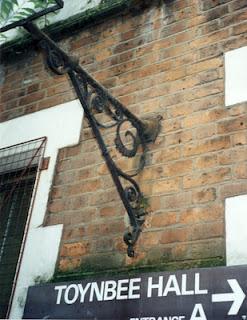
Toynbee Hall is in London's East End
In the summer and fall of 1998, during our three month stay in London, I paid a visit to Toynbee Hall, founded in 1884. I wanted to get more insight into the beginnings of the settlement house movement in England and also how it evolved--or in fact, didn't evolve--in the same way as it did in the United States. The visit was inspired by the research I did for my book, Children of the Settlement Houses, and my own background growing up in a settlement house in Minneapolis. (Until I was ten, my family lived at the Northeast Neighborhood House, now East Side Neighborhood Services, which my father directed. Go to at my website and to my Dec 14 Art and Books blog for more about my life growing up at Northeast Neighborhood House.)
Social reformers Samuel and Henrietta Bartlett founded Toynbee Hall
Much of Toynbee Hall was bombed during WWII, but the main building that has the dining room and main meeting room remains almost unchanged. I was surprised to find out that the main focus, even into the 1980's, was still residential--that college and post college students from Oxford and Cambridge would live in Toynbee Hall and the idea was that somehow this meeting of the classes in the neighborhood would result in the enlightening of the poor. I somewhat overstate the case, because there are some ongoing programs for children and the elderly at Toynbee Hall, but it doesn't seem to have the vibrancy of U.S. settlements, which as far as I can tell have changed a lot in the last hundred years to meet the needs of the time. Part of the stodginess of Toynbee Hall, I'm told, is because of the huge cutbacks in funding for social programs during the Thatcher years. Many social service agencies in Britain have still not recovered. In any case, it was fascinating for me to see the roots of the settlement house movement. You might say that if it hadn't been for Toynbee Hall my parents might never have met and I wouldn't be here today. (My parents were social workers and met in Chicago in the 1930's. They lived and worked at Association House as they were training for their careers in settlement house work.)Settlement houses still exist today, mostly in large cities, and are community centers offering a wide range of social services ranging from day care and food banks to sports and recreational programs, services for seniors, and more. A famous early settlement house in the United States is Hull House, founded by Jane Addams in Chicago. I visited Hull House, now a museum, earlier in the same summer that I visited Toynbee Hall. The neighborhood that Hull House originally served was torn down for urban renewal, but the original building is maintained by the University of Illinois. Settlements have evolved as the needs of the people in the neighborhoods around them have changed. Some have closed their doors but many continue to serve the people in their surrounding communities. Sadly, the Jane Addams Hull Association, which had served people in Chicago for 122 years, closed its doors on January 27, 2012, a victim of the economic downturn and inability to fund its programs.
In 1884 when Toynbee Hall was founded, the neighborhood around the settlement, which is in London’s East End, was largely Jewish and eastern European , but now it is almost totally Bengali. As you walk down the main shopping street you see shops filled with strange vegetables, exotic spices and beautiful saris. The neighborhood is also famous for its restaurants and on the day of my visit I had a delicious and inexpensive curry lunch at one of them.
